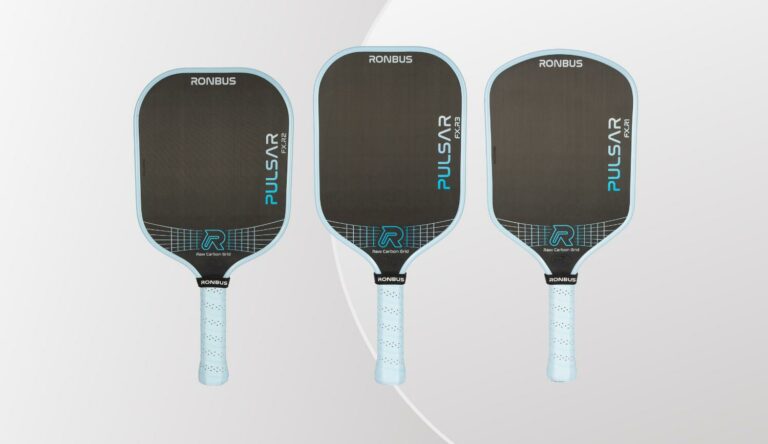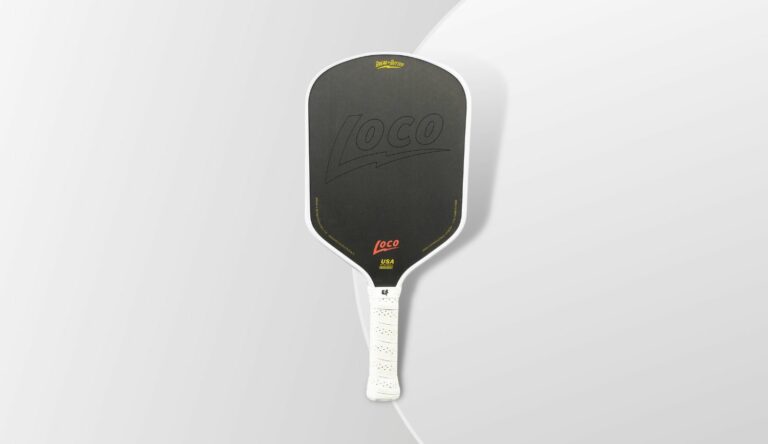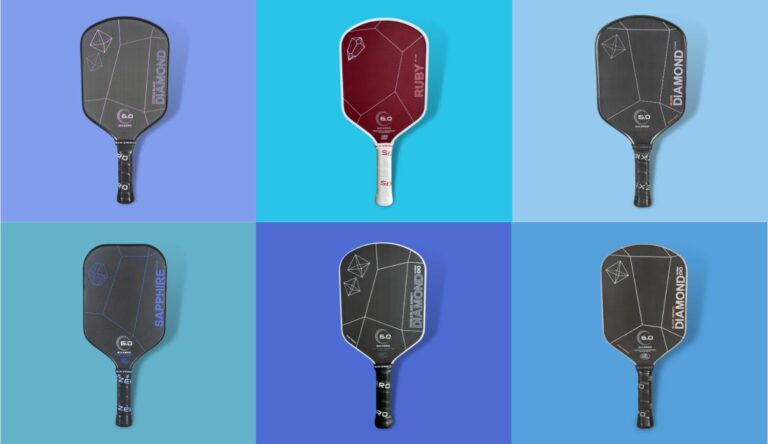Ultra-fast hand speed is one of most important traits that high-level pickleball players possess.
But developing confident, quick hands isn’t reserved for the super athletic. It can be developed by anyone with practice. Spending time and focus on building your own hand speed can be one of the most essential skill you’ll develop in your game.
You can have everything else dialed in – powerful drives, pin-point accurate drops, etc., but if you can’t hold your own at the kitchen line, you’ll be vulnerable to speed up attacks which turns you into a sitting duck for a strong opponent that knows how to exploit the situation.
In this post, you’ll learn how to hone your volley technique so that you can dominate the kitchen line.
Let’s dive in.
Contents
1. Establish an effective ready position
Having a good ready position is essential when things speed up at the kitchen. Here are some key ready position tips to help you be prepared during quick hands exchanges.
Dial in your balance and weight distribution
For quick hands you want to be in a stable stance with a low center of gravity. This stops you from getting pushed around and jumping all over the place.
You want to keep a wide base with your hips back. This enables you to counterbalance your weight in the heat of the moment and avoid losing balance or stepping into the kitchen.
While waiting for the ball, you want to be in a nice low position with your knees bent. Try to maintain good posture and avoid hunching your back.
When learning how establish a solid base in your stance, it’s good to imagine that someone is trying to push you off balance. You can sway as if being pushed. What stance makes you feel the most solid and stable? What movements do you make to counterbalance?
The biggest key is keeping your center of balance low. In fast hands exchanges, the torso and head shouldn’t be moving much at all. More on that later.
Keep your paddle up
10 o’clock used to be the recommendation, but the game has sped up since then. Now, the standard ideal paddle position you want to hold at the kitchen is maintaining your paddle at the 11 o’clock position. Note this is for right handed people, so the goal is to have the paddle leaning slightly towards the backhand side.
You want to lean backhand because you get a lot of body shots sent straight at you in hands battles and your backhand can protect those shots better than your forehand
You don’t want to go too far to the backhand position, though, because often times people will aim for the forehand side hop or shoulder. If you’re too committed to your backhand you’ll get stuck trying to hit those shots with an inefficient “chicken wing” shot.
So watch that you avoid leaning too far to the backhand side. Keep the paddle tip lined up more with the center of the body with just a slight tilt.
Adopt a consistent grip
Things move fast at the kitchen line and its best if you can seamlessly hit your forehand and backhand volleys without switching up your paddle grip constantly.
If you have to flip your grip every time you switch from forehand to backhand, you’re likely to get caught doing so by your opponent and will lose the point.
I encourage players to switch to a continental grip at the kitchen line as it helps you stay stable and consistent going back and forth between forehand and backhand shots.
2. Keep your head stable
You might have heard that in pickleball its best to keep your head still, but why do you want to do that?
One of the main reasons you want a stable head is to keep your vision focused and non-blurry. If your head is darting around a lot you won’t be able to see the ball clearly at all times. This is especially true during fast exchanges at the net. When your head moves a lot in hands battles, it becomes more likely that you’ll get disoriented.
So try to keep your head movements at a minimum. This not only applies to side to side movement, but also forward and backward head movement.
You should of course keep the ball and any necessary movements by your teammate or opponent in view. It’s important to see what type of shot your partner is hitting so you can prepare yourself. But you should only tilt your head just enough to see what’s happening.
A good exercise that you can practice to help drill this concept in is to hit the ball back and forth across the net with a friend while you’re balancing something on your head. I’ll often practice this with a wristband sitting on the top of my head. This helps you to prioritize moving with other parts of your body, your lower-half in particular.
3. Ensure that your swings and movements are tight & compact
We already discussed the importance of keeping your head stable, but this applies to our swing mechanics and entire body, as well. Short, compact swings mechanics help you stay balanced, efficient, and quick at the net.
The closer you can keep your paddle to your ready position, the quicker you’ll be able to reset and attack the next ball. It’s amazing how much faster this one adjustment makes you feel in firefights.If we instead take big swings with big follow throughs at the net we make ourselves vulnerable for the next shot that comes our way.
A good way to establish this strategy is to focus on keeping your elbow close to your body. If you can keep your elbow from straying too far from your torso then you’ll ensure that your movements aren’t getting too big.
Most importantly, your hand speed will improve dramatically when you keep your swings and movement compact like this.
Be aware that the faster the ball comes at you, the more compact you’ll want to be. If they’re blasting it at you, keep tight and try to block the ball low, ideally at their feet.
But if you opponent hits a slow ball at you, you might want to take a bigger swing so you can generate a lot of pace on the ball.
Footwork
The same applies to your footwork at the net. Less is more. If the ball comes to you try to avoid taking unnecessarily large or wide steps. You want to try to stay square and step with your outside leg. Quick shuffles that are compact are better than crossing over your legs.
4. Always be ready for the next shot
Fast volley battles are rarely about hitting one good shot one time, it’s about your ability to hit multiple times in a row.
A lot of players lose their form completely after one or more fast volleys. If you can drill it into yourself to return to your ready position quickly after every shot, you’ll be setting yourself up for success.
Whenever you’re hitting up at the net you want to be preparing yourself for the ball to come back to you. The faster you hit it, the more quickly you need to be ready for the next shot.
Balance is key here, which is why I’ve mentioned it a number of times in this article. You want to put a lot of effort and focus into keeping your balance while volleying at the NVZ. If your balance is compromised even a little bit, you may struggle to be ready for the next ball. You want to focus on having that good base with a low center of gravity and proper footwork.
You want to return to center and have your paddle up and ready to go as quick as possible into a strong ready position after you hit a quick volley.
5. Prioritize placement over power
A big reason that inexperienced players lose volley firefights is because they think they need to hit as hard as possible and overpower their opponent.
While this can work against low-level players, more highly-skilled pickleball players will have no problem handling these balls and will actually increase the pace in their returns, albeit with more precision.
When you’re hitting at your opponent, you want to focus more your ball placement and hitting key targets rather than simply hitting hard.
A main target should be the middle of their torso, their right shoulder, and their feet. Remember that you can also attempt to reset the ball by dropping a light shot into the kitchen and forcing your opponent to hit a dink. This is a good strategy to use when in a volley battle and you’re feeling that you’re losing control of the point.
6. Work on your anticipation
The best players at the kitchen line don’t just have fast hands, they have a strong sense of where their opponent is likely going to hit the ball next.
When things get fast with speed ups, you’ll have a big edge if you study your opponent and get a sense for where they like to hit the ball. You can then start to prepare for a potential return you can make that will be hard for them to deal with.
When you’re dinking, you can also start to develop a sense of when your opponent likes to speed up the ball.
7. Drill and practice for hand speed
It’s common to see people practice their drops and dinks, but you don’t oftensee people practice their volleys at the net. But drilling your volleys is an excellent thing to do. The more you practice fast hands exchanges at the net, the quicker you’ll become.
Here are some ways you can work on your hand speed by yourself or with a partner.
Hit against the wall
The easiest and simplest way to develop quick hands is to hit continuous volleys against a wall. You can get really close to the wall and practice your volleys for just a few minutes a day. The closer you get to the wall, the faster you’ll need to adjust your swing mechanics to keep hitting back and forth.
If you can easily volley back and forth with the wall at a shorter distance than the kitchen line to the net, you’ll feel much more prepared when going against opponents in a real game.
I like to balance something on my head while I do this drill, like the wristband trick I mentioned earlier in the article. This helps me remember to keep my head and torso stable while I volley.
Progressive partner volley drill
If you have a partner to hit with, you guys can each stand at the kitchen line across from each other and hit volleys back and forth. Try to work on all of the mechanics I’ve mentioned in this post so far.
After you’ve got some good volleys in, try stepping closer to each other and volleying from inside of the kitchen line. You can start with just going six inches or so closer, and as you get familiar, move even closer. Always be sure to hit both forehands and backhands without favoring one side too much.
Spend five or so minutes hitting these volleys from inside of the kitchen line, and then move back out to the standard NVZ and hit some volleys. You might be surprised at how much slower the game feels after having practiced hitting volleys so close to the net.
Always remember to keep your movements and swing mechanics tight and compact while you do this. It’s important to stay intentional when doing drills like this and not forgetting the technical and strategic components of the game.






